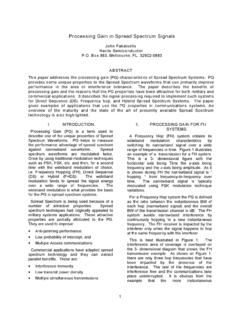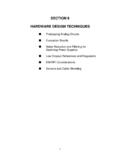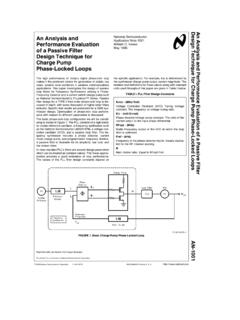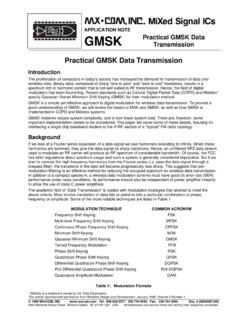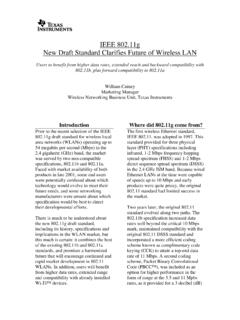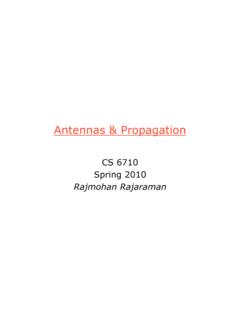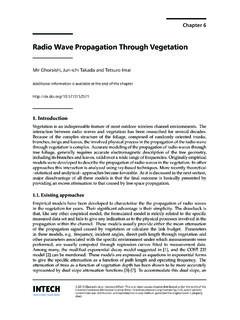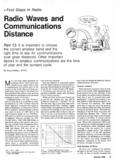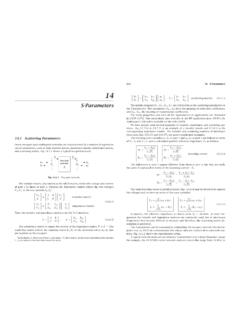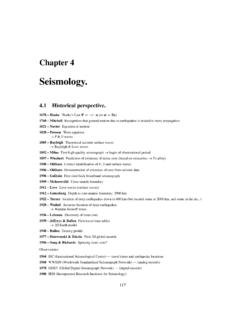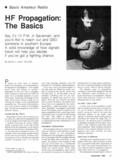Transcription of CS 294-7: Radio Propagation - Spread spectrum
1 1CS 294-7: Radio PropagationProf. Randy H. KatzCS DivisionUniversity of California, BerkeleyBerkeley, CA 94720-1776 19962 Outline A Little Physics Outdoor Propagation Indoor Propagation Propagation into Buildings3 Propagation Mechanisms Reflection Propagating wave impinges on an object which is large compared to wavelength , the surface of the Earth, buildings, walls, etc. Diffraction Radio path between transmitter and receiver obstructed by surface with sharp irregular edges Waves bend around the obstacle, even when LOS does not exist Scattering Objects smaller than the wavelength of the propagating wave , foliage, street signs, lamp posts4 Radio Propagation Effect of Mobility Channel varies with user location and time Radio Propagation is very complex Multipath scattering from nearby objects Shadowing from dominant objects Attenuation effects Results in rapid fluctuations of received powerReceiverPwr (dB)TimeInstantaneousMeanLess variation the slower you moveFor cellular telephony.
2 -30 dB, 3 sec delay spreadShort Term FadeLong Term Fade5 Radio Propagation Large scale fades Attenuation: in free space, power degrades by 1/d2 Shadows: signals blocked by obstructing structures Small scale fades Multipath effects: Rapid changes in signal strength over a small area or time interval Random frequency modulation due to varying Doppler shifts on different multipath signals Time dispersion (echoes) caused by multipath Propagation delays Even when mobile is stationary, the received signals may fade due to movement of surrounding objects!6 Radio Propagation Delay Spread Multipath Propagation yields signal paths of different paths with different times of arrival at the receiver Spreads/smears the signal, could cause inter-symbol interference, limits maximum symbol rate Typical values ( s).
3 Open < , Suburban = , Urban = 3transmittedpulsereceivedpulsedR < 12dCoherenceBandwidthTransmissionRate<7 Radio Propagation Impairments to the Radio Channel Multipath dispersion/delay Spread Signals related to previous bit/symbol interfer with the next symbol Frequency selective fading/Rayleigh fading Combination of direct and out-of-phase reflected waves at the receiver yields attenuated signals Antenna diversity: use two antennas quarter wavelength separated to combine received signals Equalization: Subtract delayed and attenuated images of the direct signal from the received signal adaptive determine what these subtractions should be, as they change as the mobile moves around8 Outdoor PropagationSignalStrength(dBm)DistanceFr ee space lossOpen areaSuburbanUrbanReceived Power Pr = Kd-n, n = 2 in free space, 3 n 4 typicallyBER = (signal stength)Error rates increase as SNR decreasesRel.
4 Pwr of receivedsignal compared topower at ref. distancefrom transmitter9 Outdoor Propagation Macro versus MicrocellsItemCell RadiusTx PowerFadingRMS Delay SpreadMax. Bit RateMacrocell1 to 20 km1 to 10 to 10 to 1 to 1 WRicean10 to 100 ns1 mbpsLOS dominatesDiffraction dominatesn = 4 RayleighLarge delay spreadReceivedPower (dB)n = 2 RiceanSmall delay spreadlog distance Breakpoint 10 Outdoor Propagation Measurements Urban areas RMS delay Spread : 2 sec Min 1 sec to max 3 sec Suburban areas RMS delay: sec to 2 sec Rural areas RMS delay: up to 12 sec GSM example Bit period sec Uses adaptive equalization to tolerate up to 15 sec of delay Spread (26-bit Viterbi equalizer training sequence)11 Indoor Propagation Physical Effects: Signal decays much faster Coverage contained by walls, etc.
5 Walls, floors, furniture attenuate/scatter Radio signals Path loss formula:Path Loss = Unit Loss + 10 n log(d) = k F + l Wwhere:Unit loss = power loss (dB) at 1m distance (30 dB)n = power-delay index d = distance between transmitter and receiverk = number of floors the signal traversesF = loss per floorI = number of walls the signal traversesW = loss per wall12 Indoor PropagationBuildingRetail StoresGrocery StoresOffice, Hard PartitionsOffice, Soft PartitionsOffice, Soft PartitionsFactory LOST extile/ChemicalTextile/ChemicalPaper/cer ealsMetalworkingSuburban homeIndoor to streetFactory OBST extile/chemicalMetalworkingFreq (MHz) ofaccuracy ofsimple model.
6 The larger the, the lessaccurate themodel13 Indoor Propagation Other Effecting Factors People moving around: Additional multipath induced attenuation of 10 dB Buildings with few metal and hard partitions: RMS delay Spread of 30 to 60 ns (several mbps w/o equalization) Buildings with metal/open aisles: RMS delay Spread of up to 300 ns (100s kbps w/o equalization) Between floors: Concrete/steel flooring yields less attenuation than steel plate flooring Metallic tinted windows yield greater attenuation 15 dB for first floor separation, 6 - 10 dB for next four floors, 1 - 2 dB for each additional floor of separation14 Indoor Measurements Received signal strength depends on: Open plan offices, construction materials, density of personnel, furniture, etc.
7 Path loss exponents: Narrowband (max delay Spread < bit period) Vary between 2 and 6, to 4 most common Wall losses: 10 dB to 15 dB Floor losses: 12 dB to 27 dB Wideband (max delay Spread > bit period) Delay Spread varies between 15 ns and 100 ns Can vary up to 250 ns Requires sophisticated equalization techniques to achieve acceptable bit error rates15 Outdoor-to-Indoor Measurements Penetration/ Building Loss Depends on building materials, orientation, layout, height, percentage of windows, transmission frequency Received signal strength increases with increasing height of building (less urban clutter at upper floors) Penetration loss decreases with increasing frequency 6 dB less loss through windows Rate of decay/distance power law: to , with average of Building attenuation loss.
8 Between 2 dB and 38 dB16 Error Mechanisms Error Burst Results of fades in Radio channels Doppler induced frequency/phase shifts due to motion can also cause loss of synchronization Errors increase as bit period approaches delay Spread Region of consecutive errors followed by stream of consecutive error-free bits Voice communication: 10-3 BER, 1 error bit in 1000 Data communications: 10-6 BER, 1 error in 1,000,00017 Error Mechanisms Average Duration of a Fade Some examples: 900 MHz, 50 km/hr -- undergoes ave fade depth of 20 dB ADF = ms m/s, ADF becomes ms Portables reside in fades for much longer time periods Renders FEC techniques inoperativeADF = 2 [ eR - 1] v RDepends on Speed of mobile (m/s)Fade depth (ratio of RMS in dB)218 Error Mechanisms Average Duration of a Fade (approximation) Some examples.
9 (R) =v2 Frequency (Mhz) (km/h)50 Speed (m/s) Depth (dB) Duration of Fade (ms) (Mhz) (km/h)2 Speed (m/s) Depth (dB) Duration of Fade (ms) (Mhz) (km/h)24 Speed (m/s) Depth (dB) Duration of Fade (ms) = R/RRMS19 Error Mechanisms Strategies for Overcoming Errors Antenna diversity (+10 dB) Dual antennas placed a / 2 separation Forward error correction (FEC) Improve fade margin through coding gain Coding gain = signal energy per bit-to-noise ratio required to attain a particular error rate with and without coding Not very effective in slowly varying Radio channels Block vs. Convolutional Codes, Interleaved vs. Non-Interleaved Automatic Repeat Request (ARQ) Retransmission protocol for blocks in error Stop and Wait, Go Back N, Selective Repeat20 Error Mechanisms11223333445555 Stop & WaitNackNackAckAckAckAck1234567 ContinuousARQ
